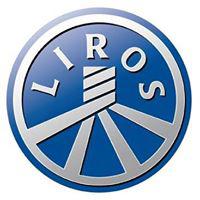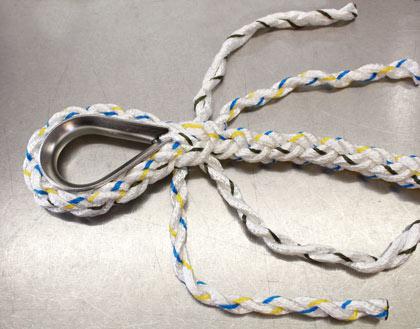LIROS Anchorplait® Nylon

Anchorplait® Article 01058JG is manufactured from 100% White Nylon (Polyamide) exclusively by LIROS Ropes for Jimmy Green Marine with the Easy Splice Markers - available from 10mm up to and including 20mm diameter.
The Jimmy Green Easy Splice Markers set Anchorplait apart from other manufacturers' eight-strand ropes.
The History of Anchorplait®
Mike Green and Alistair Green founded Jimmy Green Marine over forty years ago in 1981.
Those were pioneering days for the Jimmy Green brothers, continually seeking to advance new rope options to discerning yacht owners. Manufacturers were exploring different rope constructions to improve on the traditional three-strand configuration. Combining eight strands in one rope was an exciting development, but splicing it successfully was quite a challenge for the unpractised.
Mike designed a clever colour pattern to differentiate between the strands, making each one easier to recognise and locate correctly when attempting any splicing work.
Mike then wrote matching instructions accompanied by his own illustrations to follow the colour pattern. For those keen to learn the art, these are available to download today.
Anchorplait Splicing Instructions
After sampling and reviewing most of the rope manufacturing options in the early 1980s, Mike and Alistair established an alliance with LIROS Ropes and their UK distributor at that time, XM Yachting. The symbiotic business relationship between Jimmy Green Marine and LIROS has stood the test of time and is still flourishing. So it seemed logical to ask LIROS to manufacture the rope exclusively for Jimmy Green Marine, LIROS agreed, and the rest, as they say, is history.
Why is the name Anchorplait®?
Anchorplait has the best rope construction for Mooring Strops, especially on a swinging mooring and is the only viable option for V-shaped Bridles (more of that later). Anchorplait is also eminently suitable as a mooring line.
Still, back in the 1980s, before the advent of the modern electric windlass, anchor rodes were predominantly rope rather than chain; consequently, the warps tended to be extremely long and difficult to manage if they were the traditional three-strand twisted lay.
Anchorplait is the optimum rope for anchoring because the eight-strand balanced construction makes it flexible, easy to handle, and supremely manageable in long lengths.
Anchorplait falls from your hand and flakes on the deck or in a locker, just like an anchor chain.
To summarise, we call it Anchorplait because the name describes what it is and what it does best - a plaited rope designed for anchoring.
Anchorplait® - can anyone use the name?
Anchorplait is copyright protected, having been used continuously and prominently in our marketing since the 1980s without challenge.
Still, more significantly, it is legally protected by a Jimmy Green Marine UK Registered Trademark.
Is Anchorplait® available from other chandlers?
No, LIROS Anchorplait® White Nylon Article 01058JG is manufactured EXCLUSIVELY by LIROS Ropes for Jimmy Green Marine.
LIROS have produced countless miles of Anchorplait over four decades, but never for anyone else.
LIROS have a rope-making machine devoted exclusively to round-the-clock production for Jimmy Green Marine.
LIROS Manufacturing Excellence
LIROS are one of the world's most renowned and respected rope manufacturers.
All LIROS Yacht Ropes are produced in their modern, state-of-the-art, technically innovative 10,000 square-metre factories in Northern Bavaria, Germany.
LIROS Ropes are justifiably proud of their Quality Control which is strictly governed to DIN EN ISO9001 and DIN EN ISO14001.
Jimmy Green has been extolling the virtues of LIROS Yacht Ropes since 1982, and the collaborative partnership with LIROS and their UK distributor, Seago Yachting, continues to thrive.
LIROS Ropes have been second to none for top-quality rope consistency over the last four decades, and they keep rolling on.

Anchorplait® - the rope construction explained
Anchorplait has eight strands, divided into four equal pairs with two pairs left-hand laid (green and white) and two pairs right-hand laid (blue and yellow). Left or Right describes the direction of rotation, anticlockwise or clockwise, that is used to twist the individual yarns into each spiral strand.
Crucially, the four pairs balance each other to create a square, stable, symmetrical rope that doesn’t kink under tension.
Furthermore, the opposite pairings counter any possibility of distortion or disruption (cockling).
A continual rotational force against the natural lay of the strands can destroy three-strand rope, e.g. by a yacht persistently swinging one way around a mooring. This unfortunate phenomenon is known as cockling. Cockling can also dismantle the most secure, faultless splicing. Anchorplait is the rope that will not cockle; the balanced pairs prevent it.
Anchorplait behaves like an anchor chain – it falls straight from the windlass gypsy, or from your hand with no tendency to curl either way - it flakes down in the locker, in a bucket or on the deck in a similar way to a chain, making it easy to manage, especially for long warps.

Anchorplait® - the rope construction explained
Anchorplait® Facts, Features and Plus Factors:
- 100% UV stabilised Nylon (Polyamide)
- Non-kinking, square braid construction
- LIROS Manufacturing Consistency: Article 01058JG
- The four-pair composition (two pairs left-hand, two pairs right-hand) ensures a balanced performance and no twist under tension
- Dependable strength
- Excellent durability
- UV and abrasion resistant
- Zero possibility of cockling
- Falls and flakes like an anchor chain
- Excellent weathering and wear resistance properties
- Superb handling, manageable in long lengths
- Excellent Shock Absorbing Elongation, >20% working load stretch
- Remains supple for the duration of its working life
- Splice-able to chain - very strong 1-link splice to chain or flexible 11-link splice to chain
- Available from 10mm up to 20mm diameter
LIROS Anchorplait Nylon Break Loads in daN:
10mm 2400daN - 12mm 3300daN - 14mm 4400daN - 16mm 5600daN - 18mm 7000daN - 20mm 8140 daN - 24mm 11800daN
LIROS specify their minimum break loads in deka-newtons (daN)
Kg force is a more recognisable illustration of strength, so you can convert the LIROS daN values as follows: 1 deka-newton = approximately 1.02 kg force.
Therefore, the strength for any given diameter will be higher in kg than in daN, e.g. 11800daN = approximately 12036kg.
Anchorplait® is more than just an Anchoring Rope:
Anchoring
Anchorplait does ‘what it says on the tin.’ Anchorplait is simply the best rope for Anchoring a motor or sailing yacht.
LIROS Anchorplait Nylon Anchor Warps
Combination Anchor Rodes - Anchorplait spliced to Chain
Anchorplait can be spliced to chain with a strong, windlass-friendly connection making it ideal for a rope-chain combination anchor rode.
Liros Anchorplait Nylon Spliced to Chain
Mooring Alongside Lines
Anchorplait makes a luxurious mooring line with substantial tensile strength, excellent handling, and super shock absorbency – available on the same webpage as the anchoring warps above.
Mooring Strops
The four pairs of opposing-lay strands prevent any possibility of disruption to the rope’s integrity or splicing.
Liros Anchorplait Nylon Mooring Strops
Anchorplait is the optimum rope selection for a strop on a swinging mooring because, unlike a three-strand rope, Anchorplait will not cockle, however much it is twisted.
Mooring and Anchor Snubbing Bridles
V or Y shape bridles can divide the load between two cleats.
A Jimmy Green V-shaped bridle is based on the Anchorplait centre eye splice (with or without a thimble/chain hook).
Anchorplait has a configuration ideally suited to forming a splice in the middle of a line to form a V shape with two tails (or legs).
The bridle consists of a continuous line, made into a soft loop around a fitting or formed around a hard thimble eye with a Brummel locking tuck splice. The strength of the bridle is therefore not reliant on a Y Joining Splice, i.e. splicing two separate ropes together.
The maximum deployment angle must always be set up with caution, but the centre eye splice is much less prone to failure at a wider than optimum angle than any joining splice between two separate ropes.
It is impossible to successfully put a centre eye splice in a rope of three-strand construction.














